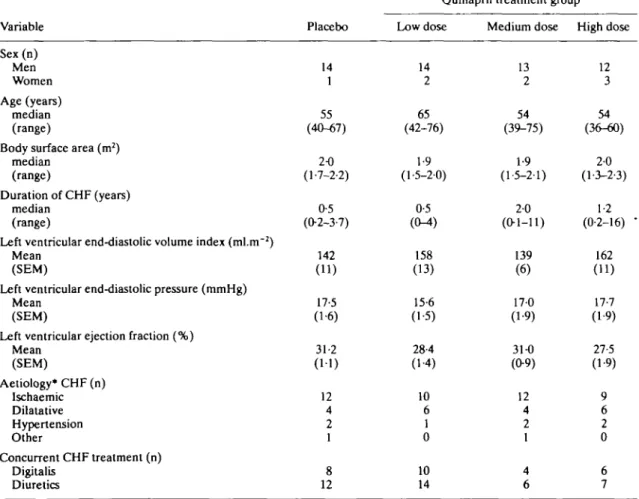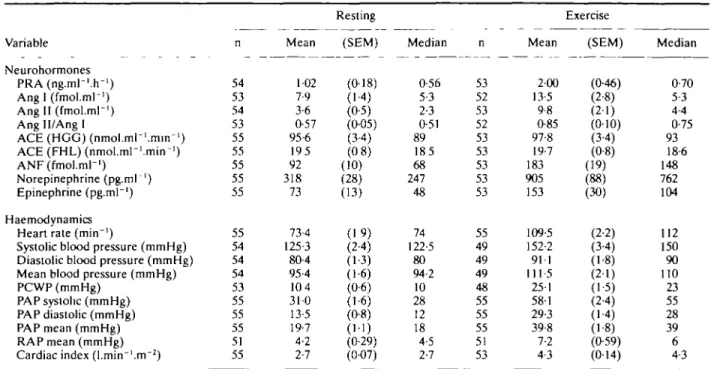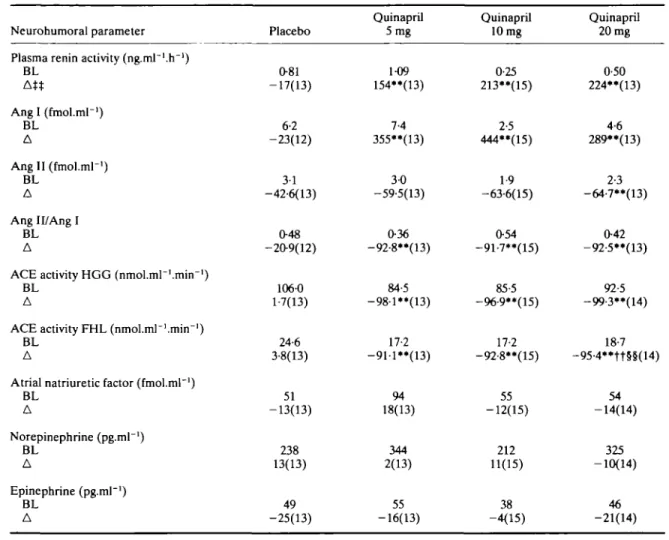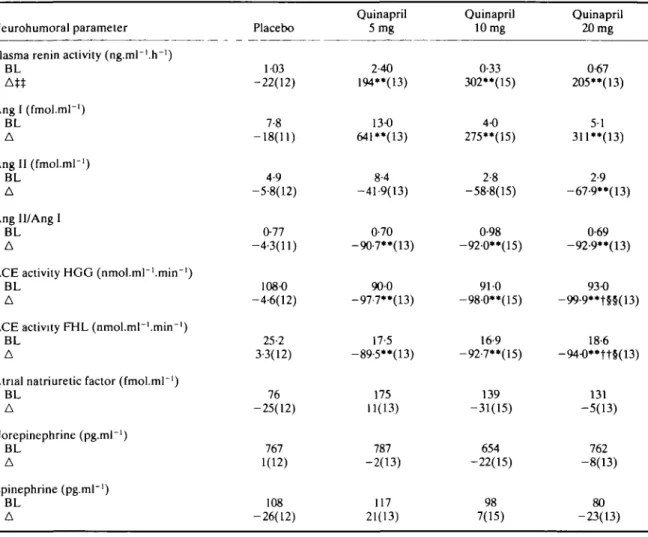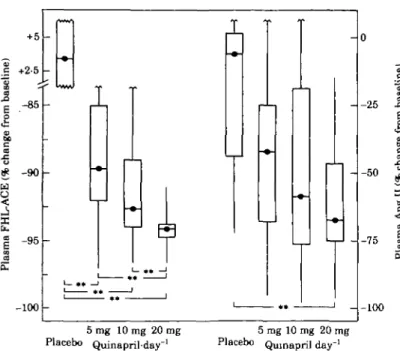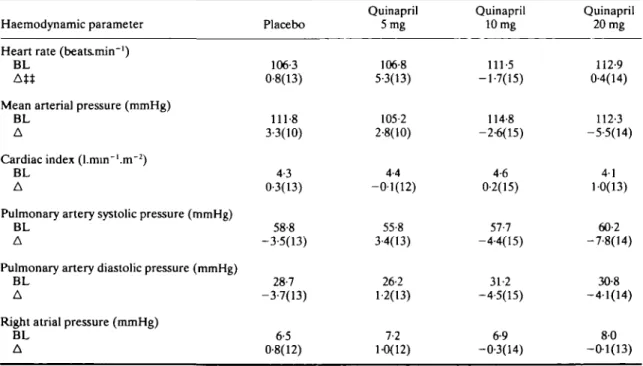Dose-related effects of ACE inhibition in man: quinapril
in patients with moderate congestive heart failure
J. NUSSBERGER*, E. FLECKf, H. BAHRMANN^, W. DELIUS§, H. P. SCHULTHEISSlI, H. R. BRUNNER* FOR THE STUDY GROUP ON NEUROHORMONAL REGULATION IN CONGESTIVE HEART FAILURE:
LAUSANNE, SWITZERLAND; BERLIN, DUSSELDORF, MUNICH, GERMANY
^University Hospital Lausanne, Switzerland; ^Deutsches Herzzentrum Berlin, Germany; \GbdeckeJParke-Davis Co., Clinical Research Department, Freiburg, Germany; §Stadtisches Krankenhaus Bogenhausen,
Munich, Germany; WMedizinische Klinik, Heinrich Heine Universitdt, Dusseldorf, Germany
KEY WORDS: Renin (PRA), angiotensin I, angiotensin II, angiotensin converting enzyme (ACE), atrial natriuretic fac-tor (ANF), norepinephrine, epinephrine, exercise.
Early treatment with ACE inhibitors of even moderate heart failure is clinically beneficial, even though haemodynamic measurements cannot adequately quantitate such improvement. Neurohumoral assessment is, however, supposed to be more accurate. In 55 patients with moderate heart failure (ejection fraction <, 35%), we investigated the dose-dependent effects of ACE inhibition with quinapril taken orally (2-5, 5 or 10 mg b.Ld.) following a placebo-controlled, parallel design protocol over 12 weeks. Plasma components of the renin angiotensin system, catecholamines and ANF were measured together with haemodynamics both at rest and during exercise. Before ACE inhibitor treatment, median PRA, Ang I and II and cate-cholamines were normal, while ANF was increased. All these parameters, including ACE activity, rose during exercise. Chronic inhibition of ACE activity was dose-dependent and the maximal fall in Ang II occurred with quinapril 20 mg.day'1. Humoral changes appeared more assessible than haemodynamic alterations even though many of these changes were reasonably correlated. The effects of chronic ACE inhibition on circulating neurohumoral components in patients with moderate heart failure are small and dose-dependent. Since humoral changes are related to haemodynamics they should account for the clinical benefit. Appropriately high doses of ACE inhibitors should be chosen for treatment of heart failure.
Introduction
The recently reported beneficial effect of early treatment with angiotensin converting enzyme (ACE) inhibition in asymptomatic patients with reduced left ventricular ejec-tion fracejec-tion is an exciting step forward in the management of congestive heart failure1'"31, and there is now little doubt
that ACE inhibitor treatment should be initiated very early in the course of the disease. Nevertheless, several questions remain to be addressed: there exists a clear need for indi-cators of incipient congestive heart failure as well as of the efficacy of therapeutic intervention. In this respect, haemo-dynamic measurements are of limited help even under exercise conditions. Neurohumoral factors are currently thought to provide some early warning of imminent dis-ease121, and they may indeed be used as a guide to assess
therapeutic effects. Plasma atrial natriuretic factor (ANF) reflects early heart failure'4' and measurement of
com-ponents of the renin angiotensin system and of cate-cholamines should be useful in evaluating the action of ACE inhibitors. However, the question of the appropriate dose of ACE inhibitor to be used remains unanswered since hardly any dose-response relationships in congestive heart failure have been reported'5'. For example, although
very low doses are commonly recommended for heart fail-ure treatment, the recently reported beneficial clinical effects were obtained with high doses.
In view of this, a placebo-controlled, double-blind
paralCorrcipondcncr. JQrg Nussberger, MD, Hypertension Division, CHUV
-H6pital Nestld, 1011 Lausanne, Switzerland.
lei design 12-week study was undertaken to investigate the dose-dependency of neurohumoral changes elicited by quinapril in patients with moderate congestive heart fail-ure under resting conditions and during exercise-induced activation. Concomitant changes in clinical and haemo-dynamic parameters were also recorded. The intention was then to interrelate neurohumoral and haemodynamic observations using adequate statistical analysis.
Methods PATIENTS
We investigated 61 patients (53 males, eight females) with congestive heart failure and a left ventricular ejection fraction, as determined by biplane left ventricular angio-graphy of <. 35% (range 15-35%, mean 30). They were 36 to 76 years old (mean 56). When entering the study, their heart failure was evaluated according to the New York Heart Association (NYHA) classification as stage II or III. They had no severe concurrent organic illnesses and patients with rapidly deteriorating chronic heart failure were excluded. Further exclusion criteria were: significant aortic or mitral stenosis, atrioventricular shunt, systolic blood pressure below 100 rnmHg, recent myocardial infarction within the 3 months preceding the study or prior treatment with ACE inhibitors.
STUDY PROTOCOL
All patients received placebo twice daily during a 2-week run-in period. Simultaneously other treatments were
optimized: digitalis and/or limited amounts of diuretics were allowed, and 15 patients with coronary artery disease received salicylic acid together with diltiazem prophylacti-cally. This concomitant treatment was then strictly main-tained throughout the following 12-week study. On the morning of the last day of the run-in period, patients remained fasting but received the usual morning dose of their concomitant treatment before right heart cath-eterization was performed. Baseline haemodynamic measurements and pulmonary artery blood samples for neurohumoral measurements were obtained after a 60 min rest in the supine position. Following ingestion of placebo, patients remained in the supine position, and haemody-namic and humoral measurements were repeated 2 and 3 h later (resting values). At 4 h post-dose and after repeat resting assessment, patients started to exercise in the supine position on a bicycle ergometer at 50 watts for 6 min. The moderate workload was chosen in order to create a second stage for the evaluation of regulatory mecha-nisms, but one which could still be met by all heart failure patients. During the last minute of exercise, haemody-namic and neurohumoral measurements were repeated (exercise values). The participants were randomly assigned to one of four treatments for the subsequent 12 weeks: fol-lowing a double-blind protocol, quinapril at 2-5,5 or 10 mg (low, intermediate or high dose) or placebo were adminis-tered orally twice a day. The full intermediate and high doses were administered on the second and third day of the study respectively. On day 84 of the randomized treatment, patients were reevaluated using the same protocol as at the end of the placebo run-in period. The protocol was approved by the Institutional Review Committees of the hospitals involved. Goals and procedures of the trial were explained to the patients and written consent was obtained.
NEUROHUMORAL ASSESSMENT
All blood samples were collected on ice into pre-chilled glass tubes containing heparin or ethylene diaminetetra acetate (EDTA) as appropriate and additional metal-loprotease and renin inhibitors for accurate angiotensin measurements. Samples were immediately centrifuged at 4°C and duplicate plasma aliquots were snap frozen in liquid nitrogen and stored at -80°C until analysed. Plasma ACE activity was measured in vitro using two different substrates, Phe-His-Leu (FHL, normal range 10-28 nmol.ml-'.min-')16'71 and Hippuryl-Gly-Gly (HGG,
normal range 70-140 nmol.ml.~1min~l)|iwl. ACE activity
was also estimated in vivo by the plasma angio-tensin Il/angioangio-tensin I (Ang l/Ang II) (normal range 0-4-2017101. Plasma renin activity (PRA) was determined
by antibody trapping of generated angiotensin I and subse-quent radioimmunossay (PRA, normal range 0-2-20 ng.ml '.h"1)'11121. Ang I and II were quantitated by
radioimmunossay after solid-phase extraction on phenylsi-lylsilica and subsequent HPLC-separation (Ang I, normal range 0-8-12 fmol.ml"1; Ang II, normal range 0-8-7-6
fmol.mr1)1'3-141. Atrial natriuretic peptide (ANF, normal
range 4-34 fmol.mr1)1'51 was also extracted on
phenylsilyl-silica and measured radioimmunologically. Plasma
norepi-nephrine (normal range 50-400 pg.ml ') and epinorepi-nephrine (normal range: 50-150 pg.ml"1) were measured
radioenzy-matically using a modification of the method of Peuler and Johnson!'5-16!.
HAEMODYNAMIC MEASUREMENTS
Right heart examinations were performed with Swan-Ganz thermodilution catheters. Blood pressure was mea-sured by sphygmomanometer. The following parameters were determined: heart rate (HR), systolic (BP syst) and diastolic blood pressure (BP diast), mean arterial pressure (MAP), cardiac output, cardiac index (CI), pulmonary cap-illary wedge pressure (PCWP), pulmonary artery systolic (PAP syst), diastolic (PAP diast) and mean pressures (PAP mean), right atrial pressure (RAP mean), total peripheral resistance (TPR) and pulmonary vascular resistance (PVR). At each time point, haemodynamic variables were measured repeatedly to guarantee stability.
DATA ANALYSIS
Changes in neurohumoral variables from baseline to the end of study were expressed as a percent of baseline because the baseline values were very inhomogenous. In contrast, absolute differences were used in the analysis of haemodynamic variables because the haemodynamic base-line values were more homogenous. Basebase-line was defined as the examination one day before starting double-blind therapy and changes from baseline were determined for matching time points only. The mean from the 2- and 3-h post-dose measurements was calculated and used to enhance accuracy for post-dose resting values. All patients who completed the study after 12 weeks of treatment (n = 55) were evaluated for efficacy.
The statistical testing procedure was related to the two objectives of the study, first to show superiority of quinapril over placebo, second to investigate the dose-response rela-tionship. For the first objective, a statistical testing hier-archy was started comparing quinapril 20 mg with placebo. Only if this showed significant results was the comparison continued for quinapril 10 mg with placebo, and similarly for quinapril 5 mg with placebo. For the second objective, the testing hierarchy compared quinapril 20 mg with 5 mg, and quinapril 10 mg with 5 mg and 20 mg. Both testing hierarchies were based on the assumption that in the pres-ence of a dose-response the dose effects are ordered by dose.
The Wilcoxon rank-sum statistical test was used with a significance level of 5%; no adjustments were made for multiple testing.
Correlations between changes from baseline as regards neurohumoral and haemodynamic variables were evalu-ated by calculating the correlation coefficient of Spearman and testing the difference of this coefficient from zero. All analyses were done using SAS (Version 6-07).
Results PATIENTS
Fifty-five patients completed the study while four men (two on placebo, two on low dose quinapril) and two women (one on low, one on high-dose quinapril) had to be
withdrawn due to lack of compliance with the protocol (four), progression of heart failure (one) and sudden death due to arrhythmia (one). Five patients had serious adverse events which could not be attributed to the ACE inhibitor treatment. Of the low dose group, one patient had chest pain with palpitations and one died. One patient in the high dose group developed haemoptysis. TWo cases of diabetes and cervical syndrome, one with accompanying thoracic pain, were observed in the placebo group. Other untoward events without any dose-relationship were: hypotension (seven), syncope (three), cough (two), rash or photosensi-tive reaction (two), pruritus (one), nausea (two), diarrhea (one) and muscle cramp (one). There were no major differences in baseline haemodynamic or neurohumoral characteristics among the four treatment groups at randomization, except for higher in vitro plasma ACE activities in patients receiving placebo during the 12-week intervention phase (Table 1). There was no apparent reason for the mismatch of the latter group. In none of the treatment groups were baseline PRA or angiotensins increased above normal; they were low in the 10 and 20 mg groups where diuretic treatment was less frequent.
NEUROHUMORAL CHANGES
Table 2 summarizes the pooled plasma neurohumoral
results of all patients at rest (means of 2 and 3 h post-dose) and after exercise at the end of the placebo run-in period. All parameters were stable during the pre-exercise phase (not shown) and median as well as mean values were within the normal range except for the clearly increased ANF concentrations. Baseline norepinephrine levels at rest were in 30/55 patients below 300 pg.ml"1, in 13/55
above 400 pg.ml"1 and in 6/55 above 600 pg.ml"'. Exercise
stimulated all humoral parameters including ACE activi-ties in vitro and in vivo (Fig. 1).
Treatment with the low, intermediate and high doses of quinapril changed all variables in the rerun angiotensin system at trough (pre-dose, not shown), resting at peak (Table 3) and during exercise (Table 4). Only the reduction in Ang II with the low and intermediate doses was not sig-nificant. Median percent decreases in Ang II levels fol-lowed the dose increases both at rest and after exercise when they were reduced by 6, 42, 59 and 68% (P < 001) for placebo, low, intermediate and high doses respectively (Fig. 2). PRA and Ang I concentrations sharply increased with all three quinapril doses at rest as well as during exer-cise (P < 0-01), but no dose-dependency was found. The dose-relationship for the reduction of ACE activity by quinapril is also depicted in Fig. 2. ACE activity was strongly inhibited in vitro (HGG, FHL) and in vivo
Table 1 Patient characteristics
Variable Sex(n) Men Women Age (years) median (range)
Body surface area (m2)
median (range)
Duration of CHF (years) median
(range)
Left ventricular end-diastolic volume index (ml.nr2) Mean
(SEM)
Left ventricular end-diastolic pressure (mmHg) Mean
(SEM)
Left ventricular ejection fraction (%) Mean (SEM) Aetiology* CHF (n) Ischaemic Dilatative Hypertension Other Concurrent CHF treatment (n) Digitalis Diuretics Placebo 14 1 55 (40-67) 2-0 (1-7-2-2) 0-5 (02-3-7) 142 (11) 17-5 (1-6) 31-2 (11) 12 4 2 1 8 12
Quinapril treatment group Low dose 14 2 65 (42-76) 1-9 (1-5-2-0) 0-5 (CM) 158 (13) 15-6 (1-5) 28-4 (1-4) 10 6 1 0 10 14 Medium dose 13 2 54 (39-75) 1-9 (1-5-2-1) 20 (0-1-11) 139 (6) 17-0 (1-9) 31-0 (0-9) 12 4 2 1 4 6 High dose 12 3 54 (36-60) 2-0 (1-3-2-3) 1-2 (0-2-16) -162 (11) 17-7 (1-9) 27-5 (1-9) 9 6 2 0 6 7
Table 2 Neurohormonal and haemodynamic data al baseline Variable Neurohormones P R A ( n g . m l - ' . r r ' ) Ang I (fmol.ml-1) Ang II (fmol.ml-1) Ang II/Ang I ACE (HGG) (nmol.ml-'.min-1) ACE (FHL) (nmol.ml-'.min-1) ANF (fmol.ml-1) Norepinephrine (pg.mr1) Epinephrine (pg.mr1) Haemodynamics Heart rate (min"')
Systolic blood pressure (mmHg) Diastolic blood pressure (mmHg) Mean blood pressure (mmHg) PCWP (mmHg)
PAP systolic (mmHg) PAP diastolic (mmHg) PAP mean (mmHg) RAP mean (mmHg) Cardiac index (l.min-'.m"2)
n 54 53 54 53 55 55 55 55 55 55 54 54 54 53 55 55 55 51 55 Mean 102 7-9 3-6 0-57 95-6 195 92 318 73 73-4 125-3 80-4 95-4 104 31-0 13-5 19-7 4-2 2-7 Resting (SEM) (0-18) (1-4) (0-5) (0-05) (34) (0 8) (10) (28) (13) (19) (24) (1-3) (1-6) (0-6) (1-6) (0-8) (1-1) (0-29) (0-07) Median 0-56 5-3 2-3 0-51 89 185 68 247 48 74 122-5 80 94-2 10 28 12 18 4-5 2-7 n 53 52 53 52 53 53 53 53 53 55 49 49 49 48 55 55 55 51 53 Mean 2-00 13-5 9-8 0-85 97-8 19-7 183 905 153 109-5 152-2 911 111-5 251 581 29-3 39-8 7-2 4-3 Exercise (SEM) (046) (2-8) (2-1) (0-10) (3-4) (0-8) (19) (88) (30) (2-2) (34) (1-8) (21) (1-5) (24) (14) (1-8) (0-59) (014) Median 0-70 5-3 4-4 0-75 93 18-6 148 762 104 112 150 90 110 23 55 28 39 6 4-3 PRA = plasma renin activity; HGG = hippuryl-glycyl-glycine; FHL = phenyl-histidyl-leucine; ANF = atnal natriuretic factor; PCWP = pulmonary capillary wedge pressure; PAP = pulmonary artery pressure; RAP = right atrial pressure.
(Ang II/Ang I) with all three doses of quinapril (P < 001, Tables 3 and 4). In contrast, chronic ACE inhibition did not affect plasma ANF, epinephrine or norepinephrine. HAEMODYNAMIC RESPONSES
Table 2 shows pooled resting and exercise
haemody-namics for all patients at the end of the placebo run-in period. As expected, during exercise, heart rate, blood pressure, right atrial pressure, pulmonary capillary wedge pressure as well as cardiac index increased, while periph-eral vascular resistance fell.
Chronic quinapril treatment induced only small
haemo-CO lin e as e n 3 CO o. J CO 1 fthe r o iM-mi n 92 89 104 91
I
Rest Exercise 1 * 17
/
/
/
,,
/
/
/
/
/
all quinapril HGG-ACE 1 8 1 1 7 . Q 26 24 Rest Exercise-„
i o' 1 ** 1V
/
/
/
/
/
all quinapril FHL-ACE 0-75 O Rat i 0-75 0-45 -_ -_ 006 p Rest Exercise I ** 1 / / / I * * 1 y <5^/ / all quinapril Ang II/Ang IFigure 1 Exercise increased plasma ACE activity. Measured with three independent
methods using hippuryl-glycyl-glycine (HGG) or phenyl-histidyl-leucine (FHL) for estima-tion in vitro and the plasma Ang II/Ang I ratio in vivo, median ACE activity increased with exercise consistently. This effect was entirely abolished after chronic treatment with quinapril while preserved under placebo. "I"" P < 005/001.
Table 3 Resting neurohumoral resultst
Neurohumoral parameter Plasma renin activity (ng.ml"'.h"!)
BL At* Ang I (fmol.ml-1) BL A Ang II (fmol.ml-1) BL A Ang 11/Ang I BL A
ACE activity HGG (nmol.mr'.mirr1)
BL A
ACE activity FHL (nmol.ml~1.mirrl)
BL A
Atrial natriuretic factor (fmol.ml"1)
BL A Norepinephrine (pg.ml"1) BL A Epinephrine (pg.ml"1) BL A Placebo 081 -17(13) 6-2 -23(12) 3-1 -42-6(13) O48 -209(12) 106-0 1-7(13) 24-6 3-8(13) 51 -13(13) 238 13(13) 49 -25(13) Quinapril 5mg 1-09 154**(13) 7-4 355**(13) 3-0 -59-5(13) 036 -92-8**(13) 84-5 -98-l**(13) 17-2 -911**(13) 94 18(13) 344 2(13) 55 -16(13) Quinapril 10 mg 0-25 213"(15) 2-5 444"(15) 1-9 -63-6(15) 054 -91-7**(15) 85-5 -96-9"(15) 17-2 -92-8**(15) 55 -12(15) 212 11(15) 38 -4(15) Quinapril 20 mg 0-50 224**(13) 4-6 289**(13) 2-3 -64-7**(13) 042 -92-5**(13) 92-5 -99-3"(14) 18-7 -95-4**tt§§(14) 54 -14(14) 325 -10(14) 46 -21(14) *• P £, O01 for quinapril 20,10 and 5 mg vs placebo,
ft P :£ O01 for quinapril 20,10 vs 5 mg, §§ P s 0-01 for quinapril 20 vs 10 mg,
based on Wilcoxon rank-sum test.
t Mean of 2 and 3 h post-dose measurements.
tt Median of the percent changes from baseline resting values.
BL = median baseline; A = median % change (n); for other explanations of abbreviations see Table 2.
dynamic changes, with very similar trough and peak effects on resting haemodynamics. Table 5 shows resting baseline pre-treatment values and the corresponding mean of absolute changes at 2-3 h after the last quinapril or placebo dose. The decrease in pulmonary artery systolic pressure was significant for the intermediate and high doses (P < 0-01). The latter finding was confirmed by similar decreases in the corresponding wedge pressures (P < 0-05) and by significant decreases in systolic pulmonary artery pressures at trough (P < 005 for intermediate, P < 0-01 for high doses). During exercise, the haemodynamic changes induced by chronic quinapril treatment tended to be greater than those observed at rest, but they did not reach statistical significance due to larger scattering of the vari-ables (Table 6).
CORRELATIONS BETWEEN NEUROHUMORAL AND HAEMODYNAMIC CHANGES
Spearman correlation coefficients for corresponding
bio-chemical and haemodynamic modifications induced by the 12-week treatment with placebo and the three quinapril doses are listed in Table 7(a) for resting and in Table 7(b) for exercise values. There were several trends pointing to a relationship between neurohumoral and haemodynamic changes. A positive correlation was found between changes in plasma ANF and in both PAP syst (R = 0-44, P < 0-01) and PAP diast (R = 0-49, P < 0-01) at rest. The lat-ter correlation remained significant during exercise (R = 0-30, P < 005). The significance of the correlation between changes in ACE activity and PAP syst at rest (FHL, R = 0-28, P < 005) was confirmed by both methods of ACE measurement when trough values were compared: FHL, R = 0-32, P < 0-05 and HGG, R = 0-36, P < 0-01 (data not shown in Table 7(a). In contrast, changes in PAP syst at rest were inversely correlated with PRA changes (R-0-43, P < 0-01). Positive correlations were also observed between changes in ACE activity and mean arterial pressure during exercise (FHL, R = 0-41,
Table 4 Exercise neurohumoral resultsX
Neurohumoral parameter Plasma renin activity (ng.ml~'.h~')
BL Angl(fmol.ml-') BL A Angll (fmol.mr1) BL A Ang Il/Ang 1 BL A
ACE activity HGG (nmol.ml~1.mirr1)
BL A
ACE activity FHL (nmol.ml~l.tnin"1)
BL A
Atrial natriuretic factor (fmol.mr1)
BL A Norepinephrine (pg.ml"1) BL A Epinephrine (pg.ml"1) BL A Placebo 1-03 -22(12) 7-8 -18(11) 4-9 -5-8(12) 077 -4-3(11) 108-0 -4-6(12) 25-2 3-3(12) 76 -25(12) 767 1(12) 108 -26(12) Quinapril 5 mg 2-40 194**(13) 13-0 641**(13) 8-4 -41-9(13) 0-70 -9O7**(13) 900 -97-7**(13) 17-5 -89-5**(13) 175 11(13) 787 -2(13) 117 21(13) Quinapril 10 mg 0-33 302**(15) 4-0 275**(15) 2-8 -58-8(15) 0-98 -92-0**(15) 91 0 -98-0**(15) 16-9 -92-7**(15) 139 -31(15) 654 -22(15) 98 7(15) Quinapril 20 mg 0-67 205**(13) 5-1 311«(13) 2-9 -67-9**(13) 0-69 -92-9**(13) 93-0 -99-9**t§§(13) 18-6 -94-0**tt§(13) 131 -5(13) 762 -8(13) 80 -23(13) " P s 001 for quinapril 20, 10 and 5 mg vs placebo,
t / t t P s 0-05/O01 for quinapril 20, 10 vs 5 mg, §/§§ P =s 005/O01 for quinapril 20 vs 10 mg,
based on Wilcoxon rank-sum test. t 6 min exercise at 50 watts, 4 h post-dose.
tt Median of the percent changes from baseline exercise values.
BL = median baseline; A = median % change (n).
P < 001 and HGG, R = 0-37, P < 005) and at rest (HGG, R = 0-27, P < 005). The latter finding was also confirmed by the FHL method at trough with R = 0-30, P < 0-05. At rest, changes in cardiac index were correlated with those of ACE activity in vivo as measured by the plasma Ang II/Ang I ratio (R = 0-28, P < 0-05) and this was again corroborated by an even better correlation at trough (R = 0-36, P < 001, not shown). During exercise, the quinapril effect on norepinephrine concentrations paral-leled changes in mean arterial pressure (R = 0-30, P < 005) and in PAP diast (R = 0-44, P < 001).
Discussion
This study was designed to assess dose-dependent effects of ACE inhibition by quinapril in patients with moderate congestive heart failure. At the outset, it seemed unlikely that dose-dependent haemodynamic effects could be demonstrated. However, in accordance with the
wide-spread opinion that neurohumoral variables are more sen-sitive and therefore better at reflecting dose-dependency of drug-induced effects, special emphasis was given to the accuracy of the methods used to measure these parameters. In the carefully characterized patients with moderate congestive heart failure, dose-dependent reduction of plasma converting enzyme activity could be demonstrated using two different methods. The effect was observed under resting as well as under exercise conditions. Interestingly, Riegger has discussed increases in exercise time as a sign for dose-dependency in his heart failure patients assuming a no difference in ACE inhibition131.
Varying degrees of ACE inhibition at the top end of the dose-response relationship may be particularly important as ACE is present in great abundance and only a few percent of remaining ACE activity, i.e. the difference between 90 and 93% inhibition, may produce distinctly different amounts of Ang II. Thus, these small modulations of plasma ACE activ-ity should, if meaningful, relate to changes in plasma Ang II
- -100 5rag 10 mg 20 mg
Placebo Quinaprilday"1
5 mg 10 mg 20 mg Placebo Qumapril day"1
Figure 2 Dose-dependency of ACE inhibition after quinapril (day 84 vs
base-line day-1). Box plots show median, interquartile range (25% to 75%) and extremes. Dose-dependency is significant for ACE activity (FHL, phenyl-his-tidyl-leucine) and suggested for plasma Ang II concentration. Depicted are values during exercise. ** P < O01.
levels. In fact, the reduction in plasma Ang II reached statis-tical significance only with the high dose of quinapril (Table 3); a clear trend towards dose-dependency of this decrease was observed during exercise (Fig. 2). At rest, the levels of plasma Ang II after 12 weeks treatment were at 1-8, 1-2, 0-7 and 0-8 fmol.ml"1 respectively with increasing doses of
quinapril. At exercise, the same values for plasma Ang II were markedly higher in the placebo and 5 mg groups, at 4-6 and 4-9 fmol.ml1, while in the 10 and 20 mg groups they were
reduced to 1-2 and 0-9 fmol.ml"1 respectively. Since only a
low level of exercise was used, these dose-dependent reduc-tions in plasma Ang II reflect treatment effects during daily life much better than resting values. Dose-dependent Ang II concentrations at moderate exercise, in turn, correlated with some haemodynamic results and thus translated into clinical effects. The neurohumoral data obtained, not only from rest-ing but even more so those measured durrest-ing exercise condi-tions, are clearly complementary to the recently published neurohumoral data from the CONSENSUS"7' and SOLVD'2'
trials.
In the present study, normal median plasma renin and Ang II levels were found in patients with moderate con-gestive heart failure and left ventricular ejection fractions below <, 35%, even though 36 out of these 55 patients were on diuretic treatment. Only seven patients had a moderately stimulated renin angiotensin system (RAS). Consequently, a major result was the relative lack of acti-vation of the plasma RAS in moderate heart failure. The plasma RAS did not seem to provide a sensitive parameter to reflect mild to moderate ventricular dysfunction and therefore could not be used as an indicator for specific therapy. Notwithstanding this, during therapy, components
of the plasma RAS reasonably correlated with haemody-namic parameters at rest and at exercise (see Table 7). Thus, the observed small changes in the plasma RAS may have mediated dose-dependent therapeutic effects
Comparable data have been obtained for plasma norep-inephrine. Despite established congestive heart failure, only 24% of our patients had clearly raised norepinephrine levels above 400 pg.ml"' when entering the trial. Thus, plasma norepinephrine levels, like plasma RAS activity, cannot be used as guidelines for therapy. Treatment-induced changes in norepinephrine were, however, associated with haemodynamic changes at exercise. Both exercise mean arterial pressure and diastolic pulmonary artery pressure changed over the 12-week treatment period together with plasma norepinephrine concentra-tions. The difference between the pre- and post-treatment changes in cardiac index and diastolic pulmonary artery pressure induced by exercise were well correlated with the corresponding changes in norepinephrine responses to exercise. We found no effect of the quinapril treatment on baseline norepinephrine plasma concentrations in our patients. This is in agreement with the findings of Goldsmith and his co-workers, who demonstrated an absent norepinephrine response to both enalaprilat and Ang II infusion in patients with moderate heart failure1'81.
Tissue catecholamines reflect cardiac dysfunction better than plasma catecholamines, so it may be that tissue Ang II is also a better indicator of disease than plasma Ang II or ACE activity. This hypothesis remains to be substantiated with adequate methodology.
An increase in plasma ACE activity during a moderate workload was observed using three different, independent
Table 5 Resting haemodynamic results%
Haemodynamic parameter Heart rate (beatsmin"1)
BL AM
Mean arterial pressure (mmHg) BL
A
Cardiac index (l.min~'.m~2)
BL A
Pulmonary artery systolic pressure (mmHg) BL
A
Pulmonary artery diastolic pressure (mmHg) BL
A
Right atrial pressure (mmHg) BL A Placebo 73-5 3-8(13) 97-6 2-9(13) 2-7 0-2(13) 31-6 5-8(13) 13-6 1-8(13) 3-7 07(12) Quinapril 5mg 76-5 -3-5(13) 96-2 -2-2(13) 2-7 -0-0(13) 30-3 1-7(13) 12-8 0-8(13) 3-4 0-2(12) Quinapril 10 mg 69-3 -1-6(15) 951 0-5(14) 2-9 0-1(15) 31-0 -2-3*'(15) 14-0 -2-0(15) 4-1 -0-8(14) Quinapril 20 mg 74-9 -1-9(14) 92-9 -0-5(14) 2-7 0-2(14) 30-9 -2-7«(14) 13-6 -0-5(14) 5-4 -0-9(13) •* P =s 001 for quinapril 20,10 mg vsplacebo,
based on Wilcoxon rank-sum test.
% Mean of 2 and 3 h post-dose treatments,
t t Mean changes from baseline resting values. BL = median baseline; A = mean change (n).
Table 6 Exercise haemodynamic resultst
Haemodynamic parameter Heart rate (beats.min~')
BL At*
Mean arterial pressure (mmHg) BL
A
Cardiac index (l.min~'.m~2)
BL A
Pulmonary artery systolic pressure (mmHg) BL
A
Pulmonary artery diastolic pressure (mmHg) BL
A
Right atrial pressure (mmHg) BL A Placebo 106-3 0-8(13) 111-8 3-3(10) 4-3 0-3(13) 58-8 -3-5(13) 28-7 -3-7(13) 6-5 0-8(12) Quinapril 5mg 106-8 5-3(13) 105-2 2-8(10) 4-4 -0-1(12) 55-8 3-4(13) 26-2 1-2(13) 7-2 1-0(12) Quinapril 10 mg 111-5 -1-7(15) 114-8 -2-6(15) 4-6 0-2(15) 57-7 -4-4(15) 31-2 -4-5(15) 6-9 -0-3(14) Quinapril 20 mg 112-9 0-4(14) 112-3 -5-5(14) 41 1-0(13) 60-2 -7-8(14) 30-8 -4-1(14) 80 -0-1(13) t 6 min exercise at 50 watts, 4 h post-dose.
t t Mean changes from baseline exercise values. BL = mean baseline; A = mean change (n).
Table 7(a) Spearman correlation coefficients for changes induced by 12-week quinapril treatment; resting conditions
Neurohormonal parameter
Plasma renin activity A n g l l
Ang Il/Ang I
ACE activity, Hip-Gly-Gly ACE activity, Phe-His-Leu Atrial natriuretic factor Norepinephrine MAP -0-24 -0-09 0-02 0-27* 0-21 0-12 0-18 Haemodynamic parameter PAP systolic - 0 - 4 3 " -0-04 0-24 0-26 0-28* 0-44" -0-07 PAP diastolic -0-26 - 0 1 6 0-12 0-18 0-19 0-49" 0-02 */•* P < 0-05/0-01.
Table 7(b) Spearman correlation coefficients for changes induced by 12-week quinapril treatment; exercise conditions
Neurohormonal parameter
Plasma renin activity Ang II
Ang 11/Ang I
ACE activity, Hip-Gly-Gly ACE activity, Phe-His-Leu Atrial natriuretic factor Norepinephrine MAP - 0 1 9 - 0 1 4 019 0-37* 0-41** -0-05 0-30* Haemodynamic parameter PAP systolic -0-18 -O06 027 0-19 0-22 0-26 0-25 PAP diastolic -0-12 -0-28* 0-28* O i l 016 0-30* 044** •/•* /)<0-05/O01.
For explanation of abbreviations see Table 2.
methods. After the treatment period, patients on placebo still had increased ACE activity during exercise whereas quinapril treatment abolished the effect (Fig. 1). It is con-ceivable that changes in blood pressure and/or flow in the lungs combined with an enhanced shear stress on the endothelial cells account for this increase in ACE activity.
The good correlation between plasma ANF and pul-monary artery pressures is not a surprise and once more emphasizes that ANF is an excellent indicator of the pres-sure load in the heart. Indeed, more than 80% of all our patients with only moderate congestive heart failure exhib-ited an elevated ANF level despite the additional fact that a majority of them were on diuretics, which are known to reduce ANF levels under physiological conditions.
In conclusion, in these patients with moderate conges-tive heart failure the plasma RAS was not activated. The effect of 3-month ACE inhibition on circulating humoral components was smaller than anticipated but more clearly dose-dependent than the haemodynamic responses.
Never-theless, these small modifications of neurohumoral vari-ables were reasonably related to haemodynamic changes and hence could account for therapeutic effects even in patients with moderate heart failure. The most favourable trends and significant changes were observed after the highest dose of quinapril, which resulted in the greatest degree of ACE inhibition and the lowest plasma Ang II levels at moderate exercise. These data suggest that for long-term treatment ACE inhibitors should not be admin-istered at a reduced dose. This is in keeping with the recent SOLVD and SAVE data which were also obtained with higher doses than those commonly recommended for initi-ation of therapy.
The study group consisted of the following physicians: Berlin: E. Fleck, V. Regitz, B. Struck, F. Wagner, Diisseldorf: H. P. Schultheiss, B. Witzenbichler, Munich: D. Antoni, W. Delius, H. J. Krieg; Lausanne: H. R. Brunner, J. Nussberger. The study group coordination and statistical evaluation was done by H. Bahrmann and J. Lilienthal, Parke Davis Co., Freiburg.
References
[1] Yusuf S and SOLVD Investigators. Effect of enalapril on sur-vival in patients with reduced left ventricular ejection frac-tions and congestive heart failure. N Engl J Med 1991; 325: 293-302.
[2] Francis GS, Benedict C, Phil D. and SOLVD Investigators. Comparison of neuroendocrine activation in patients with left ventricular dysfunction with and without congestive heart failure. Circulation 1990; 82: 1724-9.
[3] Yusuf S and SOLVD Investigators. Effect of enalapnl on mortality and the development of heart failure in asympto-matic patients with reduced left ventricular ejection fractions. N Engl J Med 1992; 327: 685-91.
[4] Gottlieb SS, Kukin ML, Adhern D et al. Prognostic impor-tance of atrial natriuretic peptide in patients with chronic heart failure. JACC 1989; 13: 1534-9.
[5] Riegger GAJ. The effects of ACE inhibitors on exercise capacity in the treatment of congestive heart failure. J Cardiovasc Pharmacol 1990; 15 (Suppl.): S41-S46.
[6] Piquilloud Y, Reinharz A, Roth M. Studies on the angiotensin converting enzyme with different substrates. Biochem Biophys Acta 1970; 206: 136-^42.
[7] Juillerat L, Nussberger J, M£nard J et al. Determinants of angiotensin II generation during converting enzyme inhibi-tion. Hypertension 1990; 12: 87-92.
[8] Cushman DW, Cheung HS. Concentrations of angiotensin converting enzyme in tissues of the rat. Biochem Biophys Acta 1971; 250: 261-5.
[9] Chen DS, Brunner HR, Waeber B. In vitro response of plasma angiotensin converting enzyme to precursors and active forms of converting enzyme inhibitors. Curr Ther Res 1984; 35-253-62.
[10] Nussberger J, Juillerat L, Perret F et al. Need for plasma angiotensin measurements to investigate converting enzyme inhibition in humans. Am Heart J 1989; 117: 717-22. [11) Poulsen K, JOrgensen J. An easy radioimmunological
microassay of renin activity, concentration and substrate in human and animal plasma and tissues based on angiotensin I trapping by antibody. J Clin Endocrinol Metab 1974; 39: 816-25.
[12] Nussberger J, Fasanella d'Amore T, Porchet M et al. Repeated administration of the converting enzyme inhibitor cilazapril to normal volunteers. J Cardiovasc Pharmacol 1987; 9:39-44.
[13] Nussberger J, Brunner DB, Waeber B et al. True versus immunoreactive angiotensin II in human plasma. Hypertension 1985; 7 (Suppl. I): 11-17.
[14] Nussberger J, Brunner HR. Measurement of angiotensins in plasma. In: Robertson JIS, Nicholls MG, eds. The renin-angiotensin system. London: Gower Medical Publishing, 1993:15.1-15.13.
[15] Nussberger J, Mooser V, Maridor L et al. Caffeine-induced diuresis and atrial natriuretic peptides. J Cardiovasc Pharmacol 1990; 15: 685-91.
[16] Peuler JD, Johnson GA. Simultaneous simple isotope radioenzymatic assay of plasma norepinephrine, epinephrine and dopamine. Life Sci 1977; 21: 625-36.
[17] Swedberg K, Eneroth P, Kjekshus J, and Consensus Trial Study Group. Hormones regulating cardiovascular function in patients with severe congestive heart failure and their relation to mortality. Circulation 1990; 82:1730-6.
[18] Goldsmith SR, Hasking GJ, Miller E. Angiotensin II and sympathetic activity in patients with congestive heart failure. JAAC1993; 15:1107-13.
